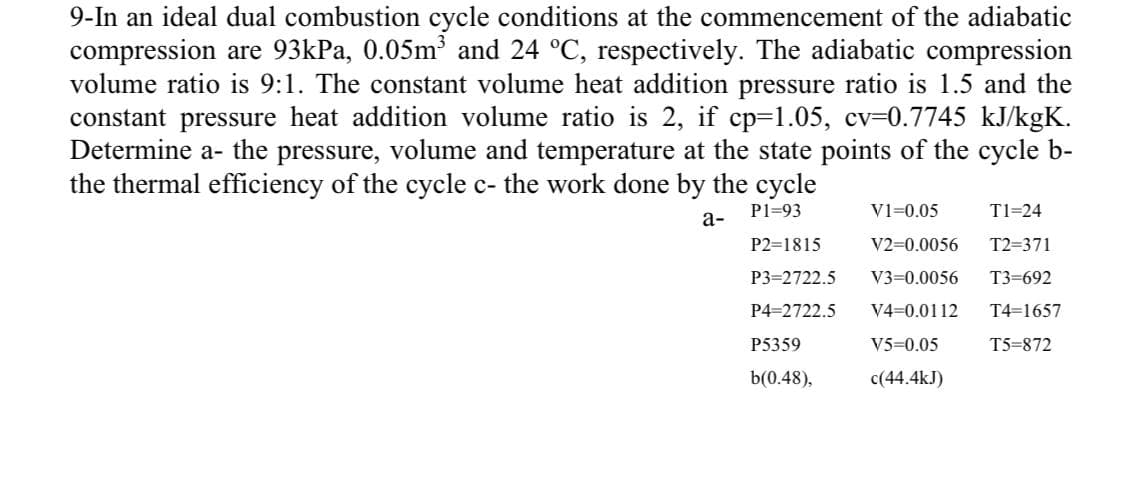9-In an ideal dual combustion cycle conditions at the commencement of the adiabatic compression are 93kPa, 0.05m and 24 °C, respectively. The adiabatic compression volume ratio is 9:1. The constant volume heat addition pressure ratio is 1.5 and the constant pressure heat addition volume ratio is 2, if cp=1.05, cv=0.7745 kJ/kgK. Determine a- the pressure, volume and temperature at the state points of the cycle b- the thermal efficiency of the cycle c- the work done by the cycle P1=93 V1=0.05 T1=24 а- P2=1815 V2=0.0056 T2=371 P3=2722.5 V3=0.0056 T3=692 P4=2722.5 V4=0.0112 T4=1657 P5359 V5=0.05 T5=872 b(0.48), c(44.4kJ)
9-In an ideal dual combustion cycle conditions at the commencement of the adiabatic compression are 93kPa, 0.05m and 24 °C, respectively. The adiabatic compression volume ratio is 9:1. The constant volume heat addition pressure ratio is 1.5 and the constant pressure heat addition volume ratio is 2, if cp=1.05, cv=0.7745 kJ/kgK. Determine a- the pressure, volume and temperature at the state points of the cycle b- the thermal efficiency of the cycle c- the work done by the cycle P1=93 V1=0.05 T1=24 а- P2=1815 V2=0.0056 T2=371 P3=2722.5 V3=0.0056 T3=692 P4=2722.5 V4=0.0112 T4=1657 P5359 V5=0.05 T5=872 b(0.48), c(44.4kJ)
Elements Of Electromagnetics
7th Edition
ISBN:9780190698614
Author:Sadiku, Matthew N. O.
Publisher:Sadiku, Matthew N. O.
ChapterMA: Math Assessment
Section: Chapter Questions
Problem 1.1MA
Related questions
Question
i need the answer quickly

Transcribed Image Text:9-In an ideal dual combustion cycle conditions at the commencement of the adiabatic
compression are 93kPa, 0.05m³ and 24 °C, respectively. The adiabatic compression
volume ratio is 9:1. The constant volume heat addition pressure ratio is 1.5 and the
constant pressure heat addition volume ratio is 2, if cp=1.05, cv=0.7745 kJ/kgK.
Determine a- the pressure, volume and temperature at the state points of the cycle b-
the thermal efficiency of the cycle c- the work done by the cycle
P1=93
V1=0.05
T1=24
а-
P2=1815
V2=0.0056
T2=371
P3=2722.5
V3=0.0056
T3=692
P4=2722.5
V4=0.0112
T4=1657
P5359
V5=0.05
T5=872
b(0.48),
c(44.4kJ)
Expert Solution
This question has been solved!
Explore an expertly crafted, step-by-step solution for a thorough understanding of key concepts.
Step by step
Solved in 5 steps with 5 images

Knowledge Booster
Learn more about
Need a deep-dive on the concept behind this application? Look no further. Learn more about this topic, mechanical-engineering and related others by exploring similar questions and additional content below.Recommended textbooks for you

Elements Of Electromagnetics
Mechanical Engineering
ISBN:
9780190698614
Author:
Sadiku, Matthew N. O.
Publisher:
Oxford University Press

Mechanics of Materials (10th Edition)
Mechanical Engineering
ISBN:
9780134319650
Author:
Russell C. Hibbeler
Publisher:
PEARSON

Thermodynamics: An Engineering Approach
Mechanical Engineering
ISBN:
9781259822674
Author:
Yunus A. Cengel Dr., Michael A. Boles
Publisher:
McGraw-Hill Education

Elements Of Electromagnetics
Mechanical Engineering
ISBN:
9780190698614
Author:
Sadiku, Matthew N. O.
Publisher:
Oxford University Press

Mechanics of Materials (10th Edition)
Mechanical Engineering
ISBN:
9780134319650
Author:
Russell C. Hibbeler
Publisher:
PEARSON

Thermodynamics: An Engineering Approach
Mechanical Engineering
ISBN:
9781259822674
Author:
Yunus A. Cengel Dr., Michael A. Boles
Publisher:
McGraw-Hill Education

Control Systems Engineering
Mechanical Engineering
ISBN:
9781118170519
Author:
Norman S. Nise
Publisher:
WILEY

Mechanics of Materials (MindTap Course List)
Mechanical Engineering
ISBN:
9781337093347
Author:
Barry J. Goodno, James M. Gere
Publisher:
Cengage Learning

Engineering Mechanics: Statics
Mechanical Engineering
ISBN:
9781118807330
Author:
James L. Meriam, L. G. Kraige, J. N. Bolton
Publisher:
WILEY